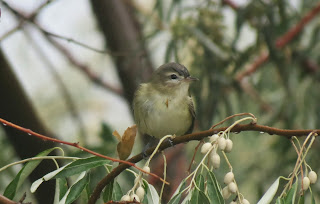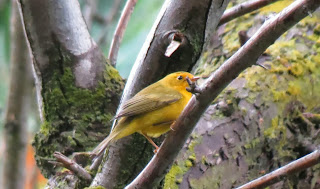DAY 1
My dad and I started out the weekend birding at Bountiful Pond on Friday evening.
My goal here was to pick up Common Tern and try to find any rare, migrating passerines.
 |
| Bountiful Pond |
Highlights here included a Common Tern, Gray Catbird, and 5 species of
Warblers (Orange-crowned, Wilson's, Macgilivray's, yellow-rumped, and a
single Yellow).
 |
| Common Tern |
 |
| Orange-crowned Warbler |
 |
| Sunset at Bountiful Pond |
No rare migrants, but plenty of the common ones. We saw good numbers of Song Sparrows, White-crowned Sparrows, Macgilivray's, Yellow-rumped, and Wilson's Warblers, Hammond's and Willow Flycatchers, and Forster's Terns. The Common Tern was a nice addition to the list as my first of the year.
Before it was completely dark, we swung over to Glover Ponds to try and find the reported Sabine's Gull and Pectoral Sandpipers. No Sabine's Gull, however I did get a quick look at one Pectoral Sandpiper. Not a satisfactory look for a year bird, but I hoped to see one the next day on the AI
Causeway.
DAY 2
Our plan was to camp, but due to the heavy rain we decided to stay in a hotel near Willard Bay. Our first stop the next morning was the Willard Spur (or West Willard Bay). This was 99% dry and only had a few birds around, which were mostly ducks. The only shorebirds we saw were a small group of American Avocets. It's amazing to think that just a few weeks ago there were hundreds of thousands of shorebirds there and now, just a few ducks and Avocets.
The next stop was at the Willard Bay Campground. It started out slow with a single Macgilivray's Warbler, a couple Yellow-rumped Warblers, and an American Robin.
 |
| Willard Bay Campground |
A few minutes later things started to pick up. We started seeing
migrants in good numbers. The most abundant bird was the Wilson's
Warbler. In the hour we spent there, we saw at least 30 different
Wilson's. Also in good numbers were Gray Catbirds, Yellow-rumped
Warblers, and Empids. Most of the Empids were either Dusky or Hammond's Flycatchers,
but we did see one Willow.
 |
| Willow Flycatcher |
 |
| Gray Catbird |
After the wooded section of Willard Bay we walked over to the dike area. Scanning the lake I was amazed at the shear number of Western/Clark's Grebes on the lake. I stopped counting at 170 something and I still wasn't even close to being done. Other birds on the lake included a small group of Pelicans, 3 Common Terns, and many Forster's Terns.
 |
| Distant Common Tern |
 |
| Forster's Tern |
 |
| A miniscule portion of the grebes on the lake. |
Antelope Island was next. The previous day a Black-and-white Warbler was reported at the ranch and we had high hopes of finding it. We arrived on the causeway at around 9:30. No Pectorals, but we did see a fairly large group of Western Sandpipers on the south side of the causeway just before the no swimming bridge. I looked through and counted the whole flock twice and couldn't find any other species mixed in. Also in the area were 4 Snowy Plovers all at the no swimming bridge where they have been hanging out for the last couple of weeks. On the "bend" (where the causeway curves) we had a group 5 Sanderling flyby. Out on the water we saw a mix of both Red-necked and Wilson's Phalaropes, Eared Grebes, Am. Avocets, and Franklin's Gulls.
 |
| Snowy Plover blending in at the NO Swimming Bridge |
 |
| Distant Flock of Western Sandpipers (158 in total) |
While watching the Western Sandpipers I saw a very large bird flying towards us heading south. It turned out to be an early Bald Eagle.
 |
| Early Bald Eagle |
Not even a minute later, another fish-eating bird of prey flew over. An Osprey.
 |
| My first Osprey for the Antelope Island Causeway |
After arriving at the ranch we could tell that the Black-and-white Warbler was a no show. All of the disappointed faces showed it. Sure enough it hadn't been seen since the day before when it was reported by the Sommerfields. There sure were a lot of birds around though. Numerous Cassin's and Warbling Vireos, Townsend's, Yellow-rumped, Macgilivray's, Wilson's, and Orange-crowned Warblers, a single Swainson's Thrush just in one little area.
 |
| First of Year (FOY) Cassin's Vireo |
 |
| Cedar Waxwing |
 |
| Orange-crowned Warbler - Seen in a mixed flock of birds soon after our arrival at the ranch. |
 |
| Swainson's Thrush - This bird doesn't have the bright spectacles normally expected for a Swainson's Thrush, but I did for sure note that it did not have a rusty tail like a Hermit Thrush. I compared it to a couple of Hermit Thrushes, which were in close proximity. |
 |
| Townsend's Warbler in bad lighting. |
One by one, the birders started to leave due to an ominous thunderstorm. My dad and I decided to stick it out. Sure enough, 5 minutes later it started to pour.
 |
| Oncoming Rain Storm |
We sat under the shelter of the ranch house until the rain was just a drizzle. I got up and wandered around the spring area and was amazed at the numbers and diversity of birds in the area. It was amazing. Lincoln's Sparrows, Green-tailed and Spotted Towhees, White-crowned Sparrows, Townsend's, Wilson's, a single Yellow, 20+ Yellow-rumped Warblers, lots of orange-crowned warblers, a Merlin, Western Tanagers, Flycatchers galore, and many, many other migrants loaded the trees in the light rain.
 |
| Lincoln's Sparrow |
 |
| First of Season (FOS) Merlin in the rain |
 |
| Townsend's Warbler |
 |
| Group of Western Tanagers (5) and a Savannah Sparrow (top left). Part of the large group of migrants that came in during the storm. |
 |
| Close up female/young Western Tanager |
I wandered out to the woodpile and found a scolding and out of place Bewick's Wren and both a Calliope and Broad-tailed Hummingbird. I had almost forgotten how small Calliope Hummingbird are. It was so small that my camera couldn't focus on it. I called my dad over and we were able to refind the Calliope Hummingbird, but not the wren or the Broad-tailed Hummer. After looking around the main part of the ranch for a little longer, we walked out to the second spring just south of the green gate. In the past this place has been a pretty good spot for birds. Here we found our first Nashville and Virginia's Warblers for the day, Gray, Hammond's, Cordilleran, Willow, and Dusky Flycatchers, a W. Wood-Pewee, numerous Western Tanagers, and interesting vireo (turned out to be a bright Warbling Vireo), and a porcupine.
 |
| Nashville Warbler |
 |
| Another Orange-crowned Warbler |
 |
| Porcupine |
 |
| Very bright Warbling Vireo. At first it struck me as a Philadelphia Vireo, but the lores aren't dark, making this a bright fall Warbling Vireo. |
 |
| Willow Flycatcher |
On our way back from the second spring, we decided to split up. I'd go around the marsh area, while my dad would go through the heart of the ranch. Here I ran into a little family of Pewees and a Savannah Sparrow.
 |
| Savannah Sparrow |
I met up with my dad along the fence by the spring. Right where we met we found a fairly large flock of mixed birds. This flock included 5 Townsend's Warblers, 3 Cassin's Vireos, numerous Wilson's Warblers, a Macgilivray's Warbler, and the highlight of the day, a RED-EYED VIREO. This bird gave me a jump start. It was sitting still right in the middle of a large tree eating a caterpillar of some sort. Its dark gray cap and lores, greenish wings, large bill, and prominent, white supercilium caught my attention. We watched it for about 12 minutes before leaving for lunch. This was a Utah first for me and a cool bird to see in general.
 |
| Cassin's Vireo - Part of the large mixed flock with the Red-eyed Vireo. |
 |
| RED-EYED VIREO |
 |
| RED-EYED VIREO - Note the dark, contrasting cap and lores, greenish wings, and large bill. Red eye is not apparent in the photos. |
 |
| Semi-cooperative Wilson's Warbler. My first decent picture of this species. |
A great two days of birding!



































No comments:
Post a Comment